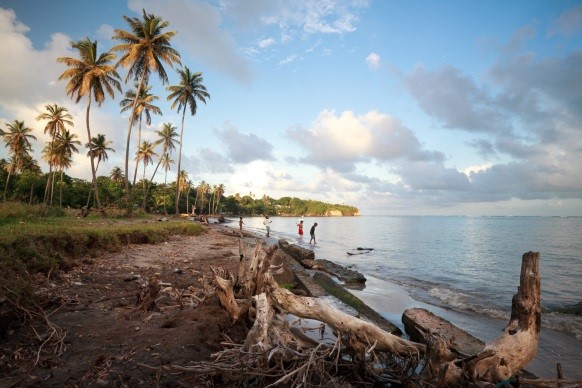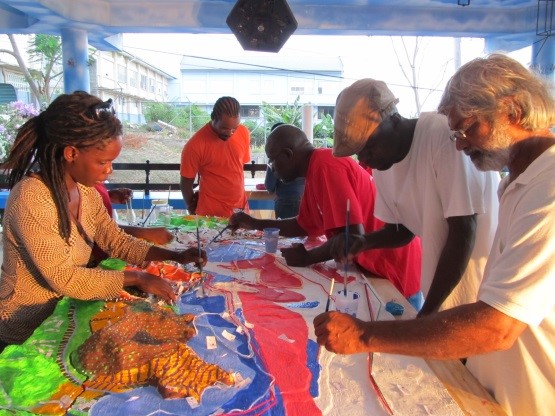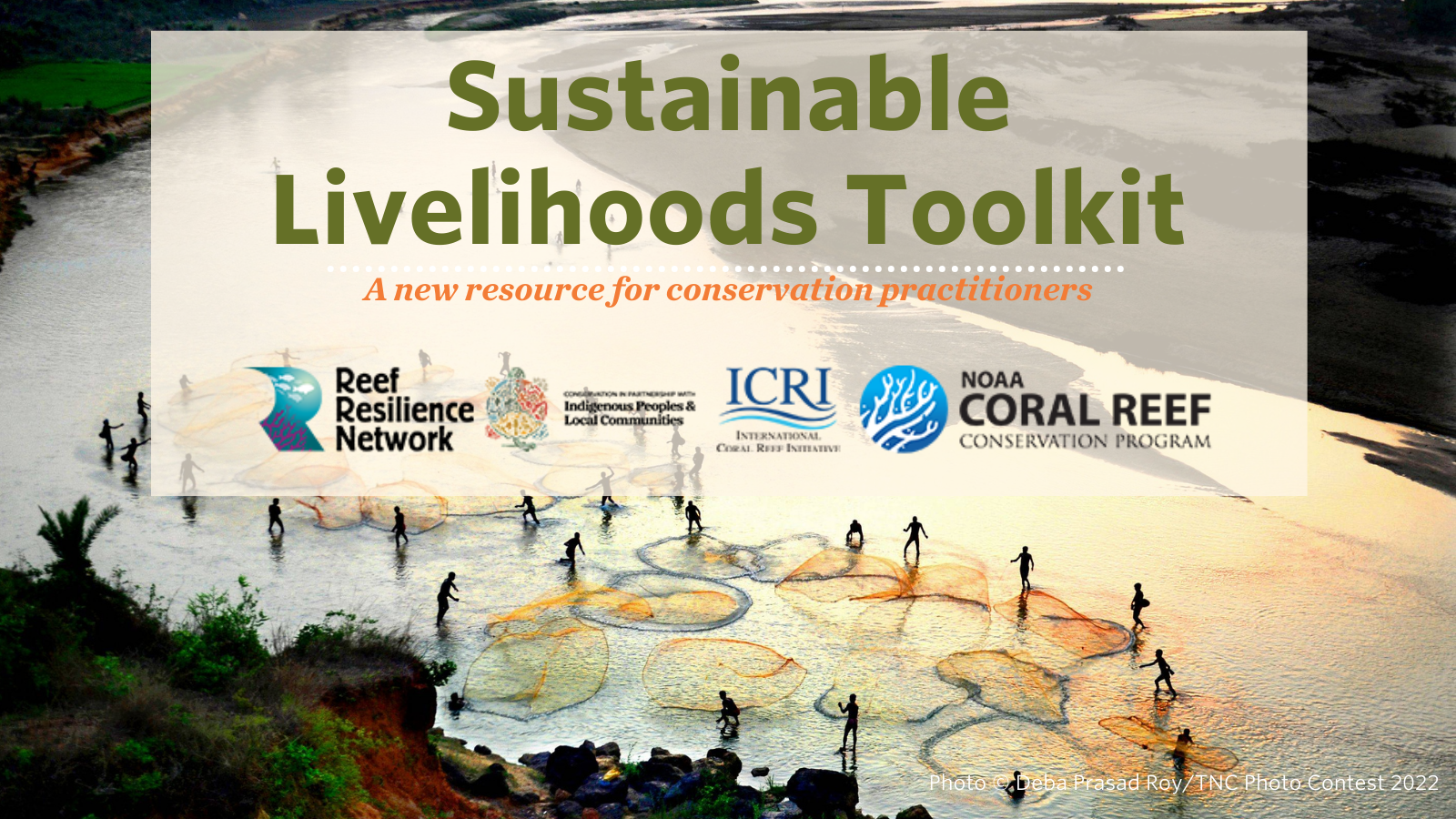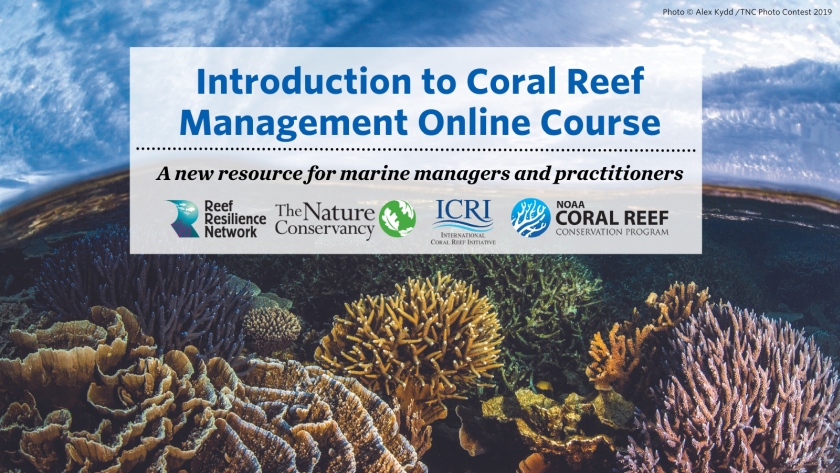At the Water’s Edge (AWE): Enhancing Coastal Resilience in Grenada
Location
Greater Grenville Area, Grenada, Eastern Caribbean
The challenge
Like most islands of the eastern Caribbean grappling with the effects of climate change, the island of Grenada is experiencing higher temperatures, more intense storms, rising sea levels, flooding, and coastal erosion. In the Greater Grenville Area of Grenada, the coastal communities of Telescope, Grenville, Soubise, and Marquis are feeling the effects. The communities of Telescope and the Town of Grenville have borne the brunt of climate impacts over the years and continue to experience changes at an increasingly alarming rate, threatening lives, food security, livelihoods and valuable coastal property.

Coastal erosion in Grenville Bay, Telescope. Photo © TNC
Actions taken
The Nature Conservancy’s At the Water’s Edge project (AWE) addresses climate impacts through the implementation of ecosystem-based adaptation solutions. These efforts are designed to support social and ecological resilience by increasing the community’s capacity to respond to climate change through strong community engagement and the implementation of nature-based solutions (e.g., restoration of coastal vegetation, installation of artificial reef structures to attenuate wave energy).
National actions to build capacity and support resilience include:
- GIS data (e.g., benthic habitats, critical infrastructure) has been gathered for the entire island
- A vulnerability analysis of Grenada was conducted, and the results provided the rationale for focusing in the Grenville Bay Area.
- GIS training workshops were held, with participation from both the public and private sectors.
- Census data by enumeration districts for the years 2001 and 2011 were spatialized with personnel from Grenada’s Department of Statistics.
- The AWE component of the Coastal Resilience website was developed with tools and data, including the census data, sea-level rise scenarios, and benthic habitats, which aided in creating maps to support decision making.
Local actions – (specific to the project communities) to build capacity and support resilience include:
- Training of At the Water’s Edge community leaders in Grenada and St. Vincent and the Grenadines.
- A participatory 3D mapping exercise was conducted with the communities. Members constructed a model of the surrounding villages and the Bay of Grenville, highlighting existing natural and cultural resources.

Community members construct a 3D model of the surrounding villages and the Bay of Grenville, highlighting existing natural and cultural resources. Photo © TNC
- The development of a community action plan and concept booklet with partners, which outlines actions and opportunities through targeted interventions for the communities.
- In collaboration with project partner Grenada Red Cross, a Vulnerability Capacity Assessment was conducted which included ecological and social data (e.g., fisheries, climate change, and community perception and use of marine ecosystems). Red Cross provides trainings to fishers and the surrounding communities on sustainable fishing practices, and the importance of coastal and marine habitats to support local communities.
- Through project partner Grenada Fund for Conservation, community members were trained to collect, care for, and outplant mangroves seedlings along specific areas of the Telescope shoreline. These trainees are being engaged in other areas of the island for mangrove restoration work with other groups.
- Innovative reef pilot structures that were developed based on 60 years of wave data were installed, utilizing a hydrodynamic model to mimic the protective functions of the reef and help dissipate wave energy before it reaches the shoreline. In January 2015, TNC joined a local commercial diving company and 12 fishermen from the surrounding communities to successfully install 30 meters of submerged breakwater on the northern reef within the bay of Grenville.
- A Community Resilience Plan was developed in collaboration with NaDMA (Grenada’s disaster management agency), International Federation of Red Cross and Red Crescent Societies, local partners, and the targeted communities.
How successful has it been?
Training community members to collect, care for, and plant mangroves within the Bay of Grenville has been a major socioeconomic achievement. Some of the community members were given a stipend to work on the project. The pilot reef structures were designed based on the following criteria and have been performing as expected:
- Must provide significant reduction in wave energy reaching the shore.
- Must last at least 30 years.
- Do not shift in heavy surf or intense storms.
- Promote natural biological growth, accretion of coralline algae and corals, and provide habitat for fish.
- Must be installed using local labor and materials at a cost less than that of a traditional breakwater.

Early view of submerged pilot reef structures in Grenville Bay. Photo © TNC
Based on scientific studies and modeling, the full shoreline can be protected if approximately 300 meters of submerged structure is built.
For the pilot, 30 meters of submerged breakwater structures were installed to ensure the model projections are accurate and to make any refinements necessary before the full structures are installed. These structures are monitored quarterly by TNC scientists, and monthly by local partners. The pilot structures have withstood winter swells, and are crusting over with crustose coralline algae, recruiting coral, dissipating wave energy, and serving as a nursery and habitat for fish. Lessons learned from this pilot are informing the design of a Living Shoreline solution to urgently address the increased erosion in critical areas along Telescope’s shores. The designs for both interventions have been completed and approved. Monitoring the pilot structures revealed that stacking the reef structures at the same height throughout led to greater exposure during low tides. Constant exposure of the structures during the periods of low tide were compromising the structures’ integrity. The final designs of the structures aim to facilitate longevity and foster greater accretion of corals and other marine life.
By June 2022, funding had been earmarked for At the Water’s Edge Phase II, which will support two components of the area’s holistic restoration: shoreline stabilization using a living shoreline approach and reef restoration using the enhanced engineered structures.
Lessons learned and recommendations
- Community engagement. The importance of sustained community engagement and involvement throughout the life of the project from conception to implementation has been critical.
- Integral partnerships with government agencies. TNC and the communities provided technical expertise and local knowledge of the project areas to make informed decisions to support AWE’s interventions.
- Ecosystem-based adaptation. Ecosystem-based adaptation can provide new and innovative solutions to climate change impacts (e.g., installing artificial reefs to provide coastal protection from storms and habitat and nurseries for fish).
Funding summary
AWE’s work has been funded by various donors over the years. Donors include but are not limited to:
- Angell Foundation
- Carnival Cruise Line
- German Federal Foreign Office, which provided the funding for the implementation of the pilot phase of the reef re-engineering works
Lead organizations
Partners
Communities of Telescope, Grenville, Soubise and Marquis
Government of Grenada
Grenada Red Cross
Grenada Fund for Conservation
Resources
For additional information on AWE including the reef brief
Coastal Resilience: Grenada and St. Vincent and the Grenadines


